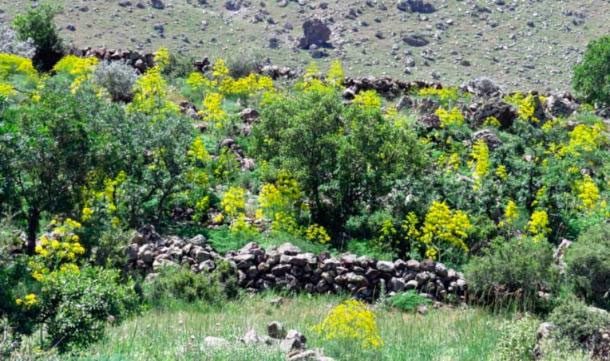An extinct plant, described in ancient Egyptian, Greek, and Roman texts as a miraculous remedy for enhancing sexual prowess and curing various ailments, has unexpectedly reemerged at the foot of a volcano.
According to Ancient Origins, this plant is known as silphion (scientific name: Ferula drudeana, also referred to as lazewort or silphium) and was highly sought after by the Egyptians, Greeks, and Romans. It was used to create a valuable resin that acted as both an aphrodisiac and a contraceptive, and it was also believed to cure many diseases.

Modern Silphion plant in Turkey and its depiction on an ancient artifact – (Photo: ANCIENT ORIGINS).
The silphion plant, characterized by its vibrant yellow flowers, once thrived in the region of Cyrene in Libya around 2,500 years ago and was meticulously described by the Roman historian Pliny the Elder, who revealed that the famous Emperor Nero consumed the last known silphion plants in the world.
This highly valued plant completely disappeared from the ancient world about 2,000 years ago.
Recently, Professor Mahmut Miski, a botanist from Istanbul University in Turkey, announced the discovery of silphion thriving robustly near Mount Hasan in Central Turkey.

A population of “miraculous” silphion in Turkey, a dream for many ancient traders – (Photo: ANCIENT ORIGINS).
In a recent study, scientists tested the medicinal properties of modern silphion on mice and confirmed that extracts from this plant significantly enhanced sexual behavior. The effects of this plant were so profound that they endorsed “both hands” the ancient claims regarding this miraculous herb.
Thus, this plant has become one of the oldest remedies for treating sexual dysfunction in the world.
According to a report from Professor Miski’s team published in National Geographic, in addition to its use as a sexual enhancer, silphion was also employed by ancient Greek physicians to treat stomach pain or warts. During Roman times, it was used as a spice in certain dishes.
Silphion was considered as valuable as silver, and the famous Roman Emperor Julius Caesar amassed a vast fortune by trading this plant.
After its disappearance, many expeditions were undertaken in search of a land where silphion might still be hidden, but all were in vain.
However, nearly 2,000 years later, in 1983, Professor Miski was walking at the foot of Mount Hasan, an active volcano in the Cappadocia region of Central Turkey, when he unexpectedly stumbled upon a carpet of yellow flowers. It wasn’t until two decades later that he recognized its resemblance to the descriptions of ancient silphion and sought to study and validate this remarkable resurgence.


















































